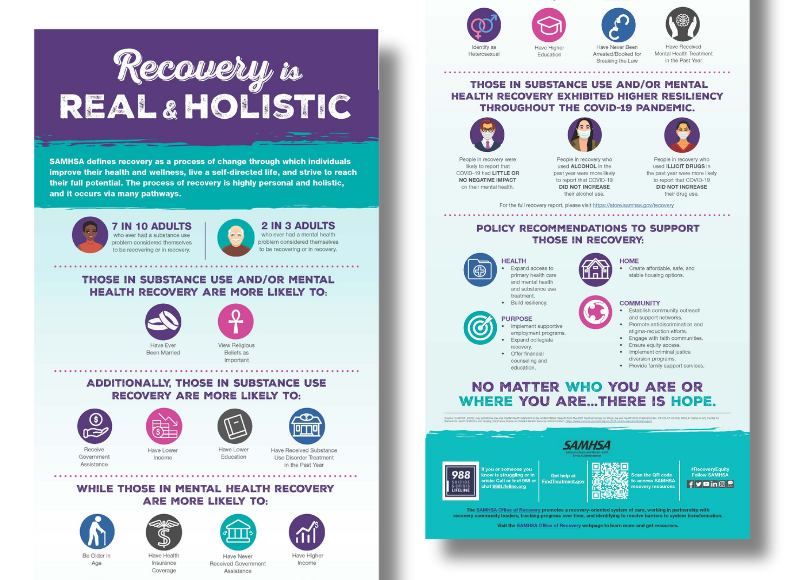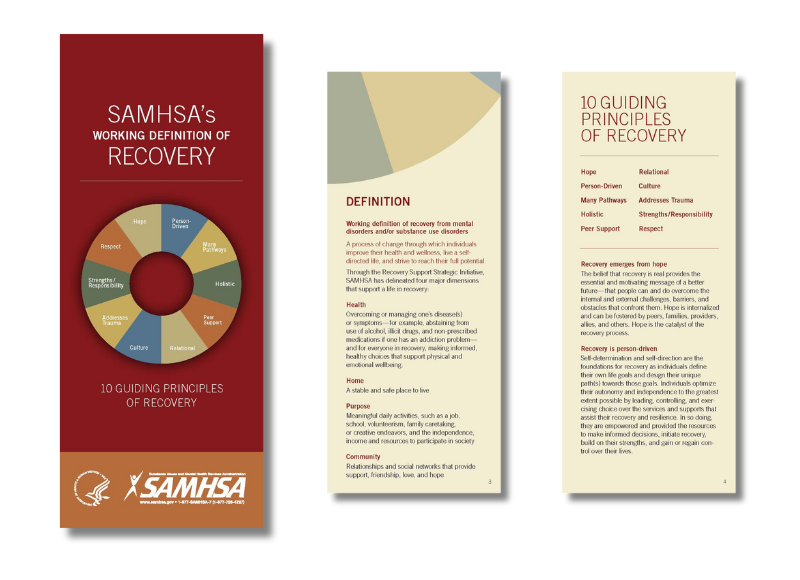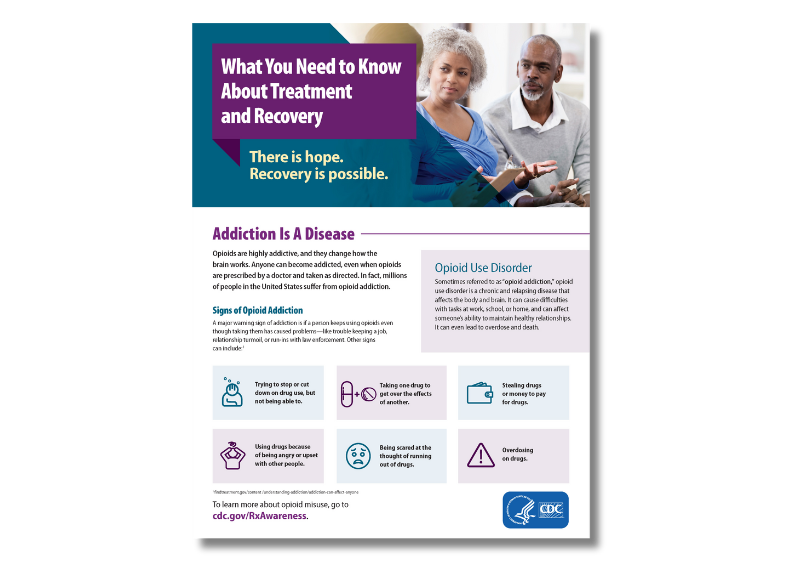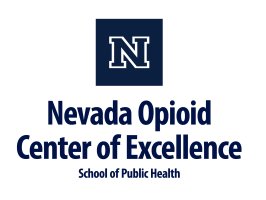SAMHSA’s working definition of recovery defines recovery as a process of change through which individuals improve their health and wellness, live self-directed lives, and strive to reach their full potential. Recovery signals a dramatic shift in the expectation for positive outcomes for individuals who experience mental and substance use conditions or the co-occurring of the two.
Guiding Principles
Hope, the belief that these challenges and conditions can be overcome, is the foundation of recovery. A person’s recovery is built on his or her strengths, talents, coping abilities, resources, and inherent values. It is holistic, addresses the whole person and their community, and is supported by peers, friends, and family members.
The process of recovery is highly personal and occurs via many pathways. It may include clinical treatment, medications, faith-based approaches, peer support, family support, self-care, and other approaches. Recovery is characterized by continual growth and improvement in one’s health and wellness and managing setbacks. Because setbacks are a natural part of life, resilience becomes a key component of recovery.
The Four Major Dimensions of Recovery
- Health – Overcoming or managing one’s disease(s) or symptoms – for example, abstaining from use of alcohol, illicit drugs, and non-prescribed medication if one has an addiction problem- and for everyone in recovery making informed, healthy choices that support physical and emotional well-being
- Home – Having a stable and safe place to live
- Purpose – Conducting meaningful daily activities, such as a job, school volunteerism, family caretaking, or creative endeavors, and the independence, income, and resources to participate in society
- Community – Having relationships and social networks that provide support, friendship, love, and hope
Websites
Nevada Recovery Friendly Workplace
In an effort to improve Nevada’s workplaces, the State of Nevada has developed a Recovery-Friendly Workplace Program to reduce the stigma of substance use and encourage workplaces to support treatment and recovery. Through education, and policy and procedure development to support recovery in all aspects, the program provides free resources to become a designated recovery-friendly workplace.
Faces & Voices of Recovery
Through collective efforts in recovery advocacy, community support, and education, Faces & Voices of Recovery promotes the right of every individual and family to recover from substance use disorder, while demonstrating the value and impact of long-term recovery.
SMART Recovery
SMART Recovery supports people in the United States, Canada, and all over the world to manage addictive and problematic behaviors. SMART Recovery is the leading, evidence-informed approach to overcoming addictive behaviors and leading a balanced life.
Tools & Resources
Recovery Friendly Workplace Toolkit
In this toolkit, the The Peer Recovery CoE introduces substance use disorder, its impact in the workplace, and how to develop and support a Recovery Friendly Workplace.
Best Practices for Recovery Housing
This document outlines best practices for the implementation and operation of recovery housing. These best practices are intended to serve as a tool for states, governing bodies, providers, recovery house operators, and other interested stakeholders to improve the health of their citizens, reduce incidence of overdose, and promote recovery housing as a key support strategy in achieving and sustaining recovery.
National Recovery Month
National Recovery Month (Recovery Month), which started in 1989, is a national observance held every September to promote and support new evidence-based treatment and recovery practices, the nation’s strong and proud recovery community, and the dedication of service providers and communities who make recovery in all its forms possible.
Medication for Opioid Use Disorder (MOUD) Tool Kit for Peer Recovery Specialists
This toolkit is a resource for Peer Recovery Specialists (PRSs) to feel equipped to discuss MOUD with providers, people seeking recovery, and others with questions about this treatment option.
Publications
Drugs, Brains, and Behavior: The Science of Addiction Treatment and Recovery
NIDA. 2023, September 25. Treatment and Recovery. Retrieved from https://nida.nih.gov/publications/drugs-brains-behavior-science-addiction/treatment-recovery on 2024, April 24
National Institute on Drug Addiction (NIDA) – About Recovery
This publication by the National Institute on Drug Addiction (NIDA) provides information about recovery.
Decisions in Recovery: Treatment for Opioid Use Disorders
This handbook provides guidance on using the web-based, multimedia tool Decisions in Recovery: Medications for Opioid Addiction. This handbook and the web-based tool offers information about medication-assisted treatment. Both resources help people living with opioid use disorder compare treatment options and discuss their preferences with a provider.
SAMHSA – Recovery and Recovery Support
This publication by the Substance Abuse and Mental Health Services Administration (SAMHSA) provides comprehensive information on recovery-oriented systems of care for individuals with substance use disorders, including opioid use disorder. It includes resources for individuals seeking recovery support services.
In My Own Words
A compilation of essays by individuals supported by Medication-Assisted Treatment in long-term recovery.
Posters & Infographics

Infographic: Recovery is Real and Holistic
Download the PDF infographic
SAMHSA’s Working Definition of Recovery
View the Infographic
Opioid Use Disorder Treatment and Recovery Fact Sheet
Webinars & Online Learning
Learn how to implement recovery-oriented principles and practices in a variety of real-world practice settings and with diverse groups of people diagnosed with behavioral health conditions in this webinar series from SAMHSA.
The Peer Recovery Center of Excellence is a peer-led national center that provides training and technical assistance related to substance use disorder recovery.
This recorded webinar from the PS ROTA-R provides an overview on the impact of stimulant use on non-metropolitan rural communities.
This recorded webinar from the PS ROTA-R provides an overview on the impact of stimulant use on non-metropolitan rural communities.
Current News & Research
Mobile Emergency Recovery Intervention Trial by Karla Wagner, PhD, University of Nevada, Reno, School of Public Health
The Mobile Emergency Recovery Intervention Trial (MERIT) is a grant-funded research study that is evaluating the effectiveness and long-term outcomes of an ER-based intervention for opioid overdose patients treated in Nevada’s Emergency Departments (EDs). The research is currently ongoing.
Published Manuscripts
- “It’s Gonna be a Lifeline”: Findings From Focus Group Research to Investigate What People Who Use Opioids Want From Peer-Based Postoverdose Interventions in the Emergency Department
- “Another tool for the tool box? I’ll take it!”: Feasibility and acceptability of mobile recovery outreach teams (MROT) for opioid overdose patients in the emergency room
- Emergency department-based peer support for opioid use disorder: Emergent functions and forms
- The mobile emergency recovery intervention trial (MERIT): Protocol for a 3-year mixed methods observational study of mobile recovery outreach teams in Nevada’s emergency departments
